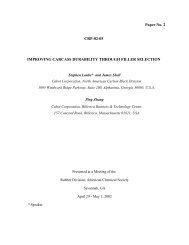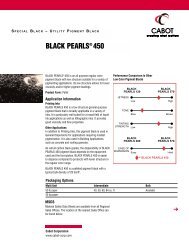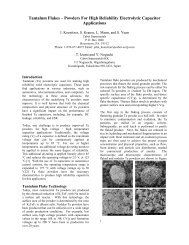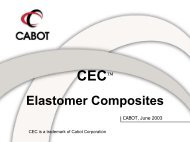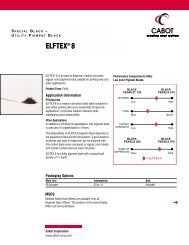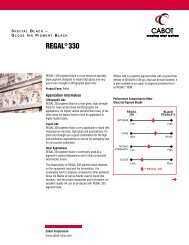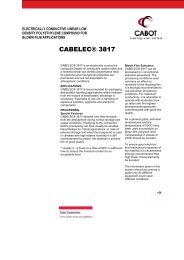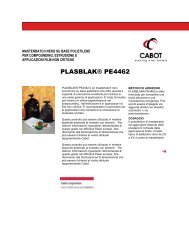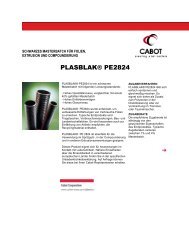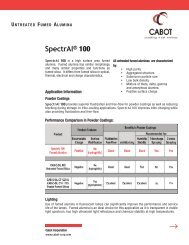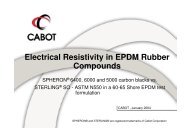Black Pigment Selection Guide for Polyester Fibre Applications
Black Pigment Selection Guide for Polyester Fibre Applications
Black Pigment Selection Guide for Polyester Fibre Applications
Create successful ePaper yourself
Turn your PDF publications into a flip-book with our unique Google optimized e-Paper software.
<strong>Black</strong> <strong>Pigment</strong> <strong>Selection</strong> <strong>Guide</strong><br />
<strong>for</strong> <strong>Polyester</strong> <strong>Fibre</strong> <strong>Applications</strong>
2<br />
<strong>Black</strong> <strong>Pigment</strong> <strong>Selection</strong> <strong>Guide</strong> <strong>for</strong> <strong>Polyester</strong><br />
<strong>Fibre</strong> <strong>Applications</strong><br />
The aim of this brochure is to assist polymer masterbatch and<br />
compound producers with their choice of the highest value black<br />
pigments <strong>for</strong> polyester fibre applications.<br />
Star Diagram<br />
A visual and accessible way to compare<br />
different black pigments on their relative<br />
suitability <strong>for</strong> the polyester fibre application<br />
is the Star Diagram. This Star Diagram<br />
compares the per<strong>for</strong>mance of three<br />
black pigments in terms of five key<br />
per<strong>for</strong>mance criteria. These per<strong>for</strong>mance<br />
measures are discussed in more detail in<br />
this guide.<br />
Value Chain<br />
25%<br />
80%<br />
CARBON BLACK SUPPLIERS<br />
PES MB PP MB PA MB<br />
MEG<br />
dispersion<br />
20%<br />
75%<br />
Filterability<br />
The Value Chain pictured here represents how Carbon <strong>Black</strong> pigments cascade<br />
stream downwards into the fabrication of textile products. Generally<br />
two routes are practised <strong>for</strong> Melt <strong>Pigment</strong>ation (mass dyeing) of polyester<br />
(PES) fibres: the masterbatch route and the liquid dispersion route. The<br />
superior economics and flexibility of the masterbatch route makes it the<br />
preferred one absorbing the growth of the black melt pigmented polyester<br />
fibres market.<br />
MASTERBATCHERS<br />
CAPTIVE LIQUID DISPERSION<br />
DMF/DMC Aqueous<br />
dispersion dispersion<br />
PES PP PA PAN VIS<br />
YARNS FABRICS FINISHING FINAL FABRICATION<br />
Blue Tone<br />
Dilutability Dispersability<br />
RAW SYNTHETIC FIBRE<br />
Colour Strength<br />
Speciality <strong>Fibre</strong> <strong>Pigment</strong> Regular <strong>Fibre</strong> <strong>Pigment</strong> Commodity <strong>Black</strong> <strong>Pigment</strong>
Market Segmentation<br />
The synthetic fibre market can be usefully segmented as depicted below. The polyester (PES) fibre segment dominates<br />
the textile fibre applications, both as continuous fibre (textile filament yarn) as well as staple fibre. Approximately 70% of<br />
the melt pigmented polyester filaments and staple fibres are black. Each sub-segment is discrete in its per<strong>for</strong>mance<br />
requirements vis-à-vis the carbon black pigment and its masterbatch. We demonstrated this in a schematic <strong>for</strong>m in the<br />
table <strong>for</strong> the two key per<strong>for</strong>mance requirements: Colour Strength and Filterability/Spinability.<br />
Segment Sub-segment<br />
Preponderance<br />
Polymer Type<br />
Textile filament yarn (up to 10 dtex) supermicro (PA<br />
micro (0.5 - 1.0 dtex) PES > PA > PP > VIS<br />
fine (1.0 - 2.5 dtex) PES > PA > PP > VIS<br />
medium (2.5 - 7.0 dtex) PES > PA > PP<br />
coarse (7 - 10 dtex) PES > PA > PP<br />
Industrial filament yarn (3-15 dtex) safety belts PES<br />
ropes/nets PA > PES<br />
industry fabrics PA > PES<br />
others PA > PES<br />
Staple fibres (up to 300 dtex) cotton type (1.3 - 2.8 dtex) PES > VIS > PAN > PP<br />
woollen type (3.3 - 10 dtex) PES > PAN > VIS > PP<br />
carpet type (10 - 300 dtex) PP > PA > PAN<br />
BCF (bulk continuous fibre-carpet-8-20 dtex) PA > PP<br />
Monofilaments (20 - 400 dtex)<br />
Special fibre types<br />
PP<br />
•<br />
= indicates degree of importance of the per<strong>for</strong>mance requirements<br />
Per<strong>for</strong>mance Measures<br />
We have defined the per<strong>for</strong>mance measures <strong>for</strong> the black melt<br />
pigmented polyester fibre application. We have organised them into<br />
per<strong>for</strong>mance measures of primary and secondary importance:<br />
Primary Per<strong>for</strong>mance Measures<br />
– Colour Strength<br />
– Filterability/Spinability<br />
– Blue Tone<br />
– Masterbatch Dilutability<br />
– Carbon <strong>Black</strong> Dispersability<br />
Colour<br />
Strength<br />
Secondary Per<strong>for</strong>mance Measures<br />
– Carbon <strong>Black</strong> Moisture Pick-up<br />
– Carbon <strong>Black</strong> Pellet Quality<br />
– Chemical Cleanliness (Processing smell)<br />
– Light Fastness<br />
– Equipment Wear<br />
– Tenacity …<br />
Filterability &<br />
Spinability<br />
••••• •••••<br />
•••• ••••<br />
••• ••••<br />
•• •••<br />
• ••<br />
• ••<br />
• ••<br />
• ••<br />
• ••<br />
••• ••••<br />
•• •••<br />
We describe hereafter each of the Primary Per<strong>for</strong>mance Measures in<br />
more detail.<br />
3
4<br />
Colour Strength (%)<br />
Colour Strength (%)<br />
180<br />
160<br />
140<br />
120<br />
100<br />
80<br />
60<br />
40<br />
20<br />
0<br />
160<br />
140<br />
120<br />
100<br />
80<br />
60<br />
40<br />
20<br />
0<br />
<strong>Fibre</strong> Colour Strength vs. <strong>Pigment</strong> Type & <strong>Pigment</strong> Concentration<br />
Colour Strength (%)<br />
160<br />
140<br />
120<br />
100<br />
80<br />
60<br />
40<br />
20<br />
0<br />
0 0.5 1.0 1.5 2.0<br />
<strong>Pigment</strong> Concentration (%)<br />
<strong>Fibre</strong> Colour Strength vs. <strong>Fibre</strong> Titre<br />
0 0.5 1 1.5 2<br />
<strong>Pigment</strong> Concentration (%)<br />
<strong>Fibre</strong> Colour Strength vs. Dullness Level & Texturisation<br />
0 1.0 2.0<br />
<strong>Pigment</strong> Concentration (%)<br />
brilliant & flat<br />
semi-dull & flat<br />
Colour Strength<br />
The Colour Strength is a measure of the total<br />
visible light absorbency of the pigmented<br />
polyester yarn. The higher the total visible<br />
light absorbency, the darker, blacker or jetter<br />
the polyester yarn will be. The Colour<br />
Strength is dependent on:<br />
• the type of black pigment used<br />
• the pigment concentration in the fibre<br />
• the titre of the fibre<br />
• the dullness level of the fibre<br />
• the texturisation of the fibre<br />
semi-dull & texturised<br />
Low Strength Type<br />
Medium Strength Type<br />
High Strength Type<br />
1.7 dtex<br />
3.6 dtex<br />
brilliant & flat<br />
semi-dull & flat<br />
semi-dull & texturised<br />
Equal Blue Tone<br />
(b* = -0.4)
Blue Tone (b*)<br />
Blue Tone (b*)<br />
0.8<br />
0.6<br />
0.4<br />
0.2<br />
0<br />
-0.2<br />
-0.4<br />
-0.6<br />
-0.8<br />
-1<br />
-1.2<br />
-0.8<br />
-0.4<br />
-0.2<br />
0<br />
-0.2<br />
-0.4<br />
-0.6<br />
-0.8<br />
-1<br />
0.5<br />
<strong>Fibre</strong> Blue Tone vs. <strong>Pigment</strong> Type & Concentration<br />
1.0 1.5 2.0<br />
<strong>Pigment</strong> Concentration (%)<br />
<strong>Fibre</strong> Blue Tone vs. <strong>Fibre</strong> Titre<br />
0.5 1.0 1.5 2.0<br />
Blue Tone (b*)<br />
0.6<br />
0.4<br />
0.2<br />
0<br />
-0.2<br />
-0.4<br />
-0.6<br />
-0.8<br />
-1<br />
<strong>Pigment</strong> Concentration (%)<br />
<strong>Fibre</strong> Blue Tone vs. Dullness & Texturisation<br />
1.0 2.0<br />
<strong>Pigment</strong> Concentration (%)<br />
Blue Tone<br />
A lot of misunderstanding exists around this<br />
per<strong>for</strong>mance measure. Very often it is a visual<br />
appreciation. Hence one confuses Blue<br />
Undertone with Colour Strength. We define<br />
Blue Tone as the undertone of polyester fibre<br />
samples measured within the CIELAB coordinates,<br />
e.g. the b*-value. The Blue Tone is<br />
dependent on:<br />
• the type of black pigment used<br />
• the pigment concentration in the fibre<br />
• the titre of the fibre<br />
• the dullness level of the fibre<br />
• the texturisation of the fibre.<br />
Low Strength Type<br />
Medium Strength Type<br />
High Strength Type<br />
1.7 dtex<br />
3.6 dtex<br />
brilliant & flat<br />
semi-dull & flat<br />
semi-dull & texturised<br />
Colour strength<br />
of 130%<br />
Colour strength<br />
of 120%<br />
5
6<br />
Pressure<br />
Delta P (bar/g pigment)<br />
120<br />
100<br />
80<br />
60<br />
40<br />
20<br />
0<br />
2.5<br />
2<br />
1.5<br />
1<br />
0.5<br />
Filterability/Spinability<br />
Polymerisation<br />
Filterability is a measure indicating the operational<br />
life-time of filter media on polyester fibre production<br />
lines. We normally encounter two types of filtration<br />
systems on industrial fibre production lines. Firstly,<br />
the CPF or Central Polymer Filtration system is a<br />
duplex filtration system with two alternating canisters each filled<br />
with metal candle filters (cartridge filters). Secondly, the Spin-pack<br />
filter system, very often a metal powder pack, is installed just<br />
be<strong>for</strong>e the spinneret. The frequency with which candle filters and<br />
spin-packs need to be replaced and/or cleaned is an important<br />
cost factor in the polyester fibre production. Elements which<br />
determine this cost are: filter cleaning charge, filter replacement<br />
cost, labour, down-time, waste material, capacity limitation,<br />
inconsistent process/quality due to frequent interruption of the<br />
production, etc.<br />
CPF Pressure Build-up<br />
3 6 9 12 15 18 21 24 27 30<br />
Days<br />
Natural <strong>Polyester</strong> Resin<br />
Regular <strong>Fibre</strong> <strong>Pigment</strong><br />
Speciality <strong>Fibre</strong> <strong>Pigment</strong><br />
Consistency Delta P results (10 microns nominal screen size)<br />
0<br />
Commodity <strong>Black</strong> <strong>Pigment</strong> Regular <strong>Fibre</strong> <strong>Pigment</strong> Speciality <strong>Fibre</strong> <strong>Pigment</strong><br />
Low<br />
Mean<br />
High<br />
Pressure<br />
Central Polymer Filtration<br />
300<br />
250<br />
200<br />
150<br />
100<br />
50<br />
0<br />
Spin-pack Filter<br />
Spinneret<br />
Spin-pack Pressure Build-up<br />
10 20 30 40 50 60 70 80 90<br />
Hours<br />
Natural <strong>Polyester</strong> Resin<br />
Regular <strong>Fibre</strong> <strong>Pigment</strong><br />
Speciality <strong>Fibre</strong> <strong>Pigment</strong><br />
Spinability covers effects like filament breakages,<br />
maximum spin yields and picking. Most masterbatch<br />
producers serving the polyester fibre market have<br />
developed an in-house filter test (Delta P test) in order to<br />
simulate and predict filterability/spinability per<strong>for</strong>mance.<br />
Cabot, as speciality pigment supplier to this market, has<br />
developed such test methodology. This Delta P test helps<br />
us in developing new pigment qualities <strong>for</strong> fibre applications<br />
(speciality fibre pigment) as well as monitoring the<br />
quality consistency of the existing speciality fibre pigment<br />
grades.
Masterbatch Dilutability<br />
Masterbatch Dilutability covers the ease with which the pigment is<br />
released by the carrier resin and is evenly distributed in the polymer<br />
matrix or polyester fibre. When Masterbatch Dilutability falls short,<br />
spinability problems will occur and/or non-homogeneous fibre<br />
pigmentation will occur. This Per<strong>for</strong>mance Measure is dependent on:<br />
• Melting Point Carrier Resin<br />
(Tm lower ☛ Dilutability higher)<br />
• Molecular Weight or Melt Viscosity Carrier<br />
Resin (MW lower ☛ Dilutability higher)<br />
• Type of Carbon <strong>Black</strong> <strong>Pigment</strong><br />
• Loading of the Carbon <strong>Black</strong> <strong>Pigment</strong><br />
(Loading lower ☛ Dilutability higher)<br />
• Presence of Low Melting Point Additive(s)<br />
(Tm lower ☛ Dilutability higher)<br />
• Masterbatch Pellet Geometry<br />
(Pellet smaller ☛ Dilutability higher)<br />
The industry uses low melting point polyester carrier resins, co-polyesters<br />
(Tm 190-200 °C) and PBT (Tm 220 °C) as opposed to PET (Tm<br />
260 °C), to overcome these problems, but this goes with a substantial<br />
cost penalty. The influence of the different black pigment grades on<br />
Masterbatch Dilutability can be approximated and compared by<br />
measuring the melt viscosity of a given masterbatch <strong>for</strong>mulation. The<br />
selection of the correct black pigment can save substantial <strong>for</strong>mulation<br />
cost when Masterbatch Dilutability is critical.<br />
Carbon <strong>Black</strong> Dispersability<br />
Carbon <strong>Black</strong> Dispersability is the ease with which the pigment can be<br />
wetted with the masterbatch carrier resin and subsequently de-agglomerated.<br />
This per<strong>for</strong>mance measure is dependent primarily on the<br />
morphology of the black pigment. It can be approximated by calculating<br />
the strength of an agglomerate, in other words the attractive <strong>for</strong>ce<br />
one needs to overcome to separate the agglomerates into discrete<br />
carbon black aggregates. This measure is independent of the system<br />
one uses to disperse the black pigment.<br />
Cabot has designed black pigments <strong>for</strong> the polyester fibre application<br />
to offer polymer masterbatch and compound producers the best<br />
balance of colour strength, blue tone, filterability, dilutability and dispersability.<br />
This technical brochure is designed to allow you to select<br />
the black pigment that will deliver the best value to your application.<br />
Cabot representatives can provide you a Star Diagram comparing<br />
those pigment grades of your interest, please call them <strong>for</strong> further<br />
details on the Cabot product line.<br />
MB Dilutability<br />
2.5<br />
2<br />
1.5<br />
1<br />
0.5<br />
PET based MB<br />
o u at o Cost s utab ty<br />
MB Formulation Cost vs. MB Dilutability<br />
0 0 1 2 3 4 5<br />
MB Formulation Cost<br />
PBT based MB<br />
Co-polyester<br />
based MB<br />
The data and conclusions contained<br />
herein are based on work believed to<br />
be reliable; however, we cannot and<br />
do not guarantee that similar results<br />
and/or conclusions will be obtained<br />
by others. Since many factors affect<br />
the production of fibres, no warranty<br />
with respect to this in<strong>for</strong>mation or<br />
patent infrignement is given or<br />
implied and we do not accept liability<br />
<strong>for</strong> any loss or damage which<br />
may result from it use.<br />
7
North America:<br />
Cabot Corporation<br />
Business and Technical Center<br />
157 Concord Road<br />
Billerica, MA 01821-7001<br />
USA<br />
Tel: (978) 663-3455<br />
Tel: (800) 462-2313 (Technical Service)<br />
Fax: (978) 670-7035 (Technical Service)<br />
Tel: (800) 526-7591 (North America Customer<br />
Service)<br />
South America:<br />
Cabot Brasil Industria e Comercio Ltda<br />
Av. Joao Castaldi 88<br />
04517-900 Sao Paulo, SP<br />
BRAZIL<br />
Tel: +55 11 5536 0388<br />
Fax: +55 11 5542 6037<br />
Middle East/Africa:<br />
Cabot Specialty Chem. Inc.<br />
Jebel Ali Free Zone<br />
LOB 15, Office 424<br />
Dubai<br />
UNITED ARAB EMIRATES<br />
Tel: +971 4 8871 800<br />
Fax: +971 4 8871 801<br />
Europe:<br />
Cabot<br />
Interleuvenlaan, 5<br />
B - 3001 Leuven<br />
BELGIUM<br />
Tel: +32 16 39 24 00<br />
Fax: +32 16 39 24 44<br />
Pacific/Asia:<br />
Cabot Specialty Chemicals, Inc.<br />
Level 14, MNI Tower 2<br />
11, Jalan Pinang<br />
50450 Kuala Lumpur<br />
MALAYSIA<br />
Tel: +60 3 2164-8352<br />
Fax: +60 3 2162-0253<br />
Notice and Disclaimer. The data and conclusions contained herein are based on work believed to be<br />
reliable; however, Cabot cannot and does not guarantee that similar results and/or conclusions will be<br />
obtained by others. This in<strong>for</strong>mation is provided as a convenience and <strong>for</strong> in<strong>for</strong>mational purposes only.<br />
No guarantee or warranty as to this in<strong>for</strong>mation, or any product to which it relates, is given or implied.<br />
CABOT DISCLAIMS ALL WARRANTIES EXPRESS OR IMPLIED, INCLUDING MERCHANTABILITY OR<br />
FITNESS FOR A PARTICULAR PURPOSE AS TO (i) SUCH INFORMATION, (ii) ANY PRODUCT OR (iii)<br />
INTELLECTUAL PROPERTY INFRINGEMENT. In no event is Cabot responsible <strong>for</strong>, and Cabot does not<br />
accept and hereby disclaims liability <strong>for</strong>, any damages whatsoever in connection with the use of or<br />
reliance on this in<strong>for</strong>mation or any product to which it relates.<br />
(c) Cabot Corporation, M.A.-U.S.A. All rights reserved<br />
www.cabot-corp.com/plastics<br />
PES.FIBRES/09.02/E



